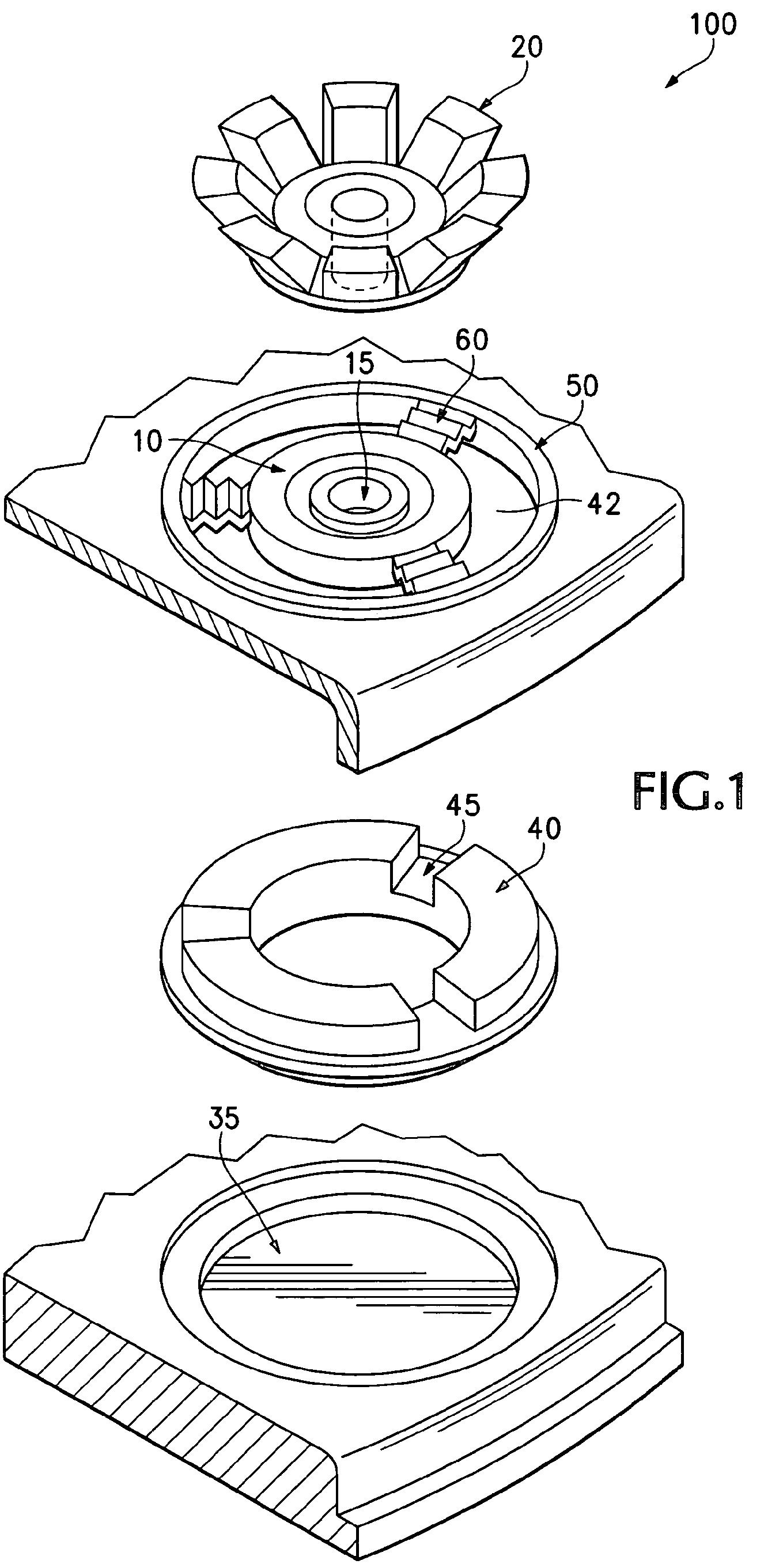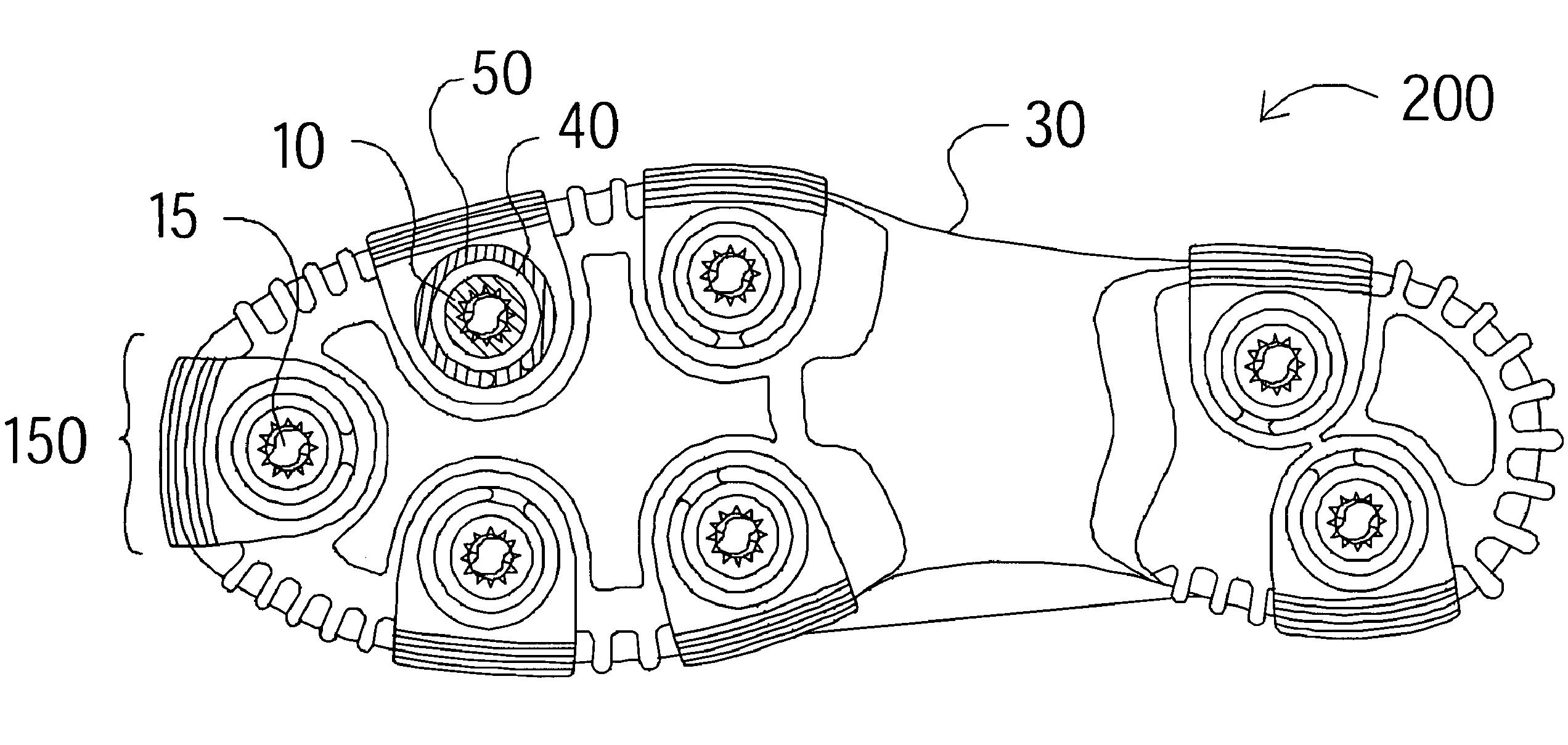Would You Play Better Golf If Your Spikes Could Rotate?
I don’t know the answer to that question, but a patent issued this week that makes me think that having spikes that independently rotate couldn’t hurt my game.
This week Callaway was granted USPN 7412784 titled “Shoe Traction System” that describes the invention as:
A shoe traction system may have an attachment element to allow the orientation of a traction device, such as a golf spike or cleat, to change relative to a sole. The system may further include a positioning element made from a resilient material and returns the spike to a neutral position. The density of the resilient material may be selected according to a weight of a user of the shoe traction system. In operation, the shoe traction system may allow each spike secured to the outsole to form a dynamic positioning system for uneven or varying ground surfaces. The spikes may work independently of each other and all spikes may be adjusting at all times to any change in surfaces.


The patent goes on to describe the need for the invention…
Athletic shoes, such as golf shoes, typically comprise an outsole having spikes or cleats secured to the outsole. The outsole is the element of the shoe that contacts the ground. The spikes or cleats extend from the outsole and contact the ground to improve traction of the shoe. The spikes or cleats may be formed of one-piece construction with the outsole. Alternatively, the spikes may be removable and secured to the outsole. In either case, the orientation of the spike or cleat is fixed with respect to the outsole when the shoe is in use.
Walking on shoes with spikes becomes difficult when surface types and levels change. For example, a user may be walking on level ground of cement, gravel, dirt, or grass. The user may then walk on a hillside or a slope, or the ground may become uneven. Thus, it is desirable to have a shoe traction system that can provide proper traction and grip on different types of surfaces and changing surface levels.
Walking on shoes with spikes becomes difficult when surface types and levels change. For example, a user may be walking on level ground of cement, gravel, dirt, or grass. The user may then walk on a hillside or a slope, or the ground may become uneven. Thus, it is desirable to have a shoe traction system that can provide proper traction and grip on different types of surfaces and changing surface levels.
The patent goes on to explain…
Some of the inventive principles of this patent disclosure relate to a shoe traction system having an attachment element to allow the orientation of a traction device to change relative to a sole. For example, a golf shoe may have an attachment element with a receptacle for a spike or cleat. The spike or cleat may also be integral to the attachment element.
The system may include a positioning element which may be made from a resilient material and returns the spike or cleat to a neutral position. The density of the resilient material may be selected according to a weight of a user of the shoe traction system.
In another embodiment, the inventive principles of this disclosure relate to an athletic shoe having an upper and a sole including one or more resilient sockets to receive one or more traction devices.
In yet another embodiment, the inventive principles of this disclosure relate to a method including attaching a traction device to an athletic shoe and rocking the traction device responsive to the surface on which the shoe is used. The method includes returning the traction device to a neutral position when the traction device is not in contact with the surface. The method also includes attaching a second traction device to the shoe and rocking the second traction device independently of the first traction device responsive to the surface.
In still yet another embodiment, the inventive principles of this patent disclosure relate to a shoe traction system having an attachment means for allowing the orientation of a traction device to change relative to a sole. The system may also include a positioning means for dynamically adjusting the orientation of the traction device.
The system may include a positioning element which may be made from a resilient material and returns the spike or cleat to a neutral position. The density of the resilient material may be selected according to a weight of a user of the shoe traction system.
In another embodiment, the inventive principles of this disclosure relate to an athletic shoe having an upper and a sole including one or more resilient sockets to receive one or more traction devices.
In yet another embodiment, the inventive principles of this disclosure relate to a method including attaching a traction device to an athletic shoe and rocking the traction device responsive to the surface on which the shoe is used. The method includes returning the traction device to a neutral position when the traction device is not in contact with the surface. The method also includes attaching a second traction device to the shoe and rocking the second traction device independently of the first traction device responsive to the surface.
In still yet another embodiment, the inventive principles of this patent disclosure relate to a shoe traction system having an attachment means for allowing the orientation of a traction device to change relative to a sole. The system may also include a positioning means for dynamically adjusting the orientation of the traction device.
Interesting stuff!
David Dawsey – The Golf Patent Lawyer
PS – click here to check out another interesting golf shoe invention
